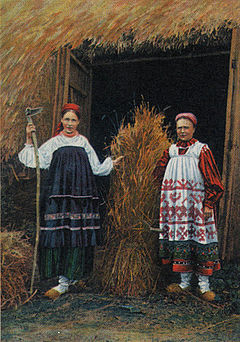Dożynki
| Dożynki | |
|---|---|

Last sheaf. Russia. Photos of the early 20th century
|
|
| Also called | Russian: Обжинки 'Obzhynki'; Belarusian: Прачыстая 'Prachystaya'; Czech: Dožínky; Dormition |
| Observed by | Slavic people |
| Significance | The end of the harvest crops |
| Date |
August 15 (28). In some regions of Russia Dozhinki rites performed September 8 (21) or September 14 (27). |
August 15 (28). In some regions of Russia Dozhinki rites performed September 8 (21)
Dożynki (Dozhinki, Ukrainian: Обжинки, lit. 'Obzhynky' 'Obzhynky', Polish: Dożynki, Russian: Обжинки 'Obzhynki'; Belarusian: Прачыстая 'Prachystaya'; Czech: Dožínky, Obžinky; Dormition) is a Slavic harvest festival. In pre-Christian times the feast usually fell on the autumn equinox (23 September), in modern times it is usually celebrated on one of the Sundays following the end of the harvest season, which fall on different days in different regions of Europe.
The feast was initially associated with the pagan Slavic cult of plants, trees and agriculture. In 16th century in Central and Eastern Europe it gained a Christian character and started to be organised by the landed gentry and more affluent peasants as a means to thank the reapers and their families for their work, both during the harvest and during the past year.
While there are many regional varieties and traditions, most have some aspects in common. Often the peasants or farmers celebrating dożynki gather in the fields outside their village, form a procession and bring back a sheaf or the last batch of cereal reaped from nearby fields. The women would then turn it into a wreath and offer it to the guest of honour (usually the organiser of the celebration: a local noble, the richest farmer in the village or – in modern times – the vogt or other representative of the authorities).
...
Wikipedia
